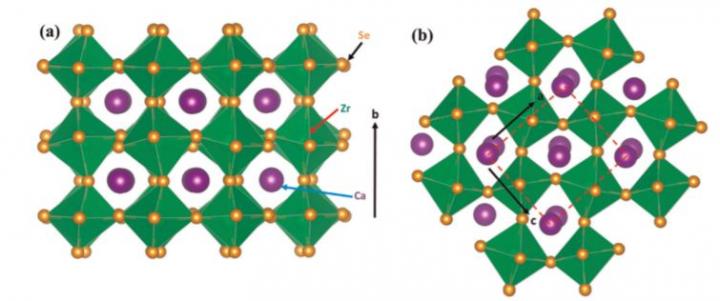Mapping the energy transport mechanism of chalcogenide perovskite for solar energy use

CaZrSe3 in the distorted orthorhombic perovskite phase depicted from the (a) side view and (b) top view. Credit: Ganesh Balasubramanian, Eric Osei-Agyemang and Challen Enninful Adu
For solar cells to be widely used in the coming decades researchers must resolve two major challenges: increasing efficiency and lowering toxicity.
Solar energy works through a process that converts light into energy called the photovoltaic effect. Certain light sensitive materials when packaged together in a “cell” have the ability to convert energy from light into electricity.
Most of today's solar cells require a highly processed form of Silicon. The processing results in toxic effects on humans and the environment. According to an article published in AZO Materials in 2015, many strides have been made since the first solar cell was developed, but average efficiency rates are still well below 30 percent, with many cells barely reaching 10 percent efficiency.
Researchers have recently been working with a material?an emerging chalcogenide perovskite CaZrSe3?that has shown great potential for energy conversion applications because of its notable optical and electrical properties.
“These materials hold extreme promise for solar energy conversion applications,” says Ganesh Balasubramanian, assistant professor of mechanical engineering at Lehigh University's P.C. Rossin College of Engineering and Applied Science. “One can potentially design them as solar thermoelectric materials that convert thermal energy from the sun to usable electric power.”
Balasubramanian, working with postdoctoral student Eric Osei-Agyemang and undergraduate Challen Enninful Adu, have for the first time, revealed first-hand knowledge about the fundamental energy carrier properties of chalcogenide perovskite CaZrSe3. They have published their findings in NPJ Computational Materials in an article called “Ultralow lattice thermal conductivity of chalcogenide perovskite CaZrSe3 contributes to high thermoelectric figure of merit.” This work compliments a recent article by the same team published in Advanced Theory and Simulations called “Doping and Anisotropy-Dependent Electronic Transport in Chalcogenide Perovskite CaZrSe3 for High Thermoelectric Efficiency.”
“Together they provide a holistic look at the transport properties of these materials,” says Balasubramanian. “They also demonstrate that chalcogenide perovskite CaZrSe3 can potentially be used for waste heat recovery or solar energy conversion to electricity.”
To arrive at their results, the team performed quantum chemical calculations examining the electronic and lattice properties of these materials to derive useful material transport information.
The news that energy transport through advanced materials such as chalcogenides can be tuned by nano structuring should be welcomed by other researchers in the field, says Balasubramanian, bringing scientists closer to applying these techniques to achieve a solar energy production method that is cheaper, more efficient and less toxic.
Media Contact
More Information:
http://dx.doi.org/10.1038/s41524-019-0253-5All latest news from the category: Materials Sciences
Materials management deals with the research, development, manufacturing and processing of raw and industrial materials. Key aspects here are biological and medical issues, which play an increasingly important role in this field.
innovations-report offers in-depth articles related to the development and application of materials and the structure and properties of new materials.
Newest articles

A universal framework for spatial biology
SpatialData is a freely accessible tool to unify and integrate data from different omics technologies accounting for spatial information, which can provide holistic insights into health and disease. Biological processes…

How complex biological processes arise
A $20 million grant from the U.S. National Science Foundation (NSF) will support the establishment and operation of the National Synthesis Center for Emergence in the Molecular and Cellular Sciences (NCEMS) at…

Airborne single-photon lidar system achieves high-resolution 3D imaging
Compact, low-power system opens doors for photon-efficient drone and satellite-based environmental monitoring and mapping. Researchers have developed a compact and lightweight single-photon airborne lidar system that can acquire high-resolution 3D…





















